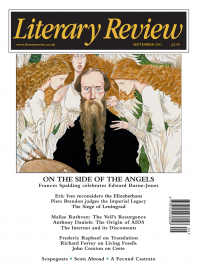Malise Ruthven
Lifting the Veil
A Quiet Revolution: The Veil’s Resurgence, from the Middle East to America
By Leila Ahmed
Yale University Press 352pp £18.99
In 1956 the historian Albert Hourani, best known for his magisterial History of the Arab Peoples, wrote a short article in the UNESCO Courier predicting that the hijab or veil worn by Muslim women would disappear from ‘advanced’ Arab countries like Egypt, surviving only in ‘backward regions’ such as Yemen and Saudi Arabia where the ‘old order’ persisted. More than half a century on, the veil is proudly, even defiantly, worn by Harvard undergraduates, not to mention the female half of an audience that filled Oxford’s Sheldonian Theatre for a discussion I attended last year between Professor Tariq Ramadan and Shaikh Hamza Yusuf Hanson, the distinguished American convert. In the post-9/11 world, as Leila Ahmed points out in this gripping yet erudite book, the veil worn by women in Western countries such as Britain and America has come to symbolise a range of public postures, from the resistance to Islamophobia or anti-Muslim prejudice experienced on the domestic front, to expressions of support for Muslim women in places such as Iraq, Bosnia, Somalia or Palestine, exemplified by the group that calls itself ‘Scarves for Solidarity’. How is it, Ahmed asks, that a form of head-covering once seen as a symbol of patriarchal oppression can now be regarded as a call for justice?
Her answers, as one would expect from one of the world’s foremost writers on issues of gender in Islam, are complex and nuanced, and it does no service to her scholarship to reduce them to crude résumés. After revisiting her native Egypt where, prior to the recent protests,

Sign Up to our newsletter
Receive free articles, highlights from the archive, news, details of prizes, and much more.@Lit_Review
Follow Literary Review on Twitter
Twitter Feed
The era of dollar dominance might be coming to an end. But if not the dollar, which currency will be the backbone of the global economic system?
@HowardJDavies weighs up the alternatives.
Howard Davies - Greenbacks Down, First Editions Up
Howard Davies: Greenbacks Down, First Editions Up - Our Dollar, Your Problem: An Insider’s View of Seven Turbulent...
literaryreview.co.uk
Johannes Gutenberg cut corners at every turn when putting together his bible. How, then, did his creation achieve such renown?
@JosephHone_ investigates.
Joseph Hone - Start the Presses!
Joseph Hone: Start the Presses! - Johannes Gutenberg: A Biography in Books by Eric Marshall White
literaryreview.co.uk
Convinced of her own brilliance, Gertrude Stein wished to be ‘as popular as Gilbert and Sullivan’ and laboured tirelessly to ensure that her celebrity would outlive her.
@sophieolive examines the real Stein.
Sophie Oliver - The Once & Future Genius
Sophie Oliver: The Once & Future Genius - Gertrude Stein: An Afterlife by Francesca Wade
literaryreview.co.uk